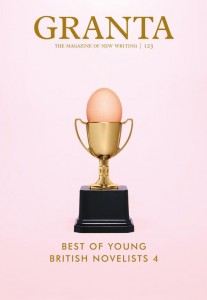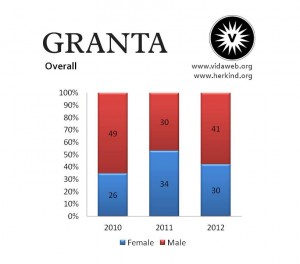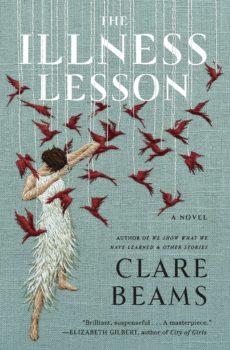 Earlier this week, Granta released the results of its fourth “Best of British Novelists.” Of the 20 writers whose work is included in the most recent issue, 12 were women, which is an encouraging number after the most recent study by VIDA: Women in Literary Arts. Their annual survey, which was published in March, revealed that, by the numbers, not much has changed since last year; male writers still outnumber female writers at most major literary magazines as contributors, editors, reviewers, and review subjects.
Earlier this week, Granta released the results of its fourth “Best of British Novelists.” Of the 20 writers whose work is included in the most recent issue, 12 were women, which is an encouraging number after the most recent study by VIDA: Women in Literary Arts. Their annual survey, which was published in March, revealed that, by the numbers, not much has changed since last year; male writers still outnumber female writers at most major literary magazines as contributors, editors, reviewers, and review subjects.
Though Granta’s list would seem to contradict some of VIDA’s findings, NPR commentator Annalisa Quinn is critical of this apparent shift in demographic:
[Granta’s “Best of British Novelists” list] is not reflected by other publications: the recently released VIDA count, which tracks the gender balance of reviewers and authors in places such as the New York Times, Harper’s, and the Paris Review, shows that women are still strikingly under-represented in most major literary magazines. To claim, as Granta does, that the best voices naturally rise to the top seems to trivialize how many real barriers there are in the literary world for women and minorities.
Two years ago, after VIDA’s 2010 survey results were announced in February of 2011, then Blog Editor (now Editor-at-Large) Celeste Ng decided to put FWR’s gender disparity—or lack thereof—to the test.
She discovered that though it wasn’t a perfect 50/50 split, the disparity was much more even here on our site compared to many of the publications in VIDA’s report. In fact, in the categories of staff, overall contributors, interviewers, and reviewers, the scale was slightly tipped in favor of women. And though our percentage of reviews of books written by men was somewhat higher (56%), as was the percentage of interview subjects who were men (also, 56%), this is a fairly small discrepancy.
This year we decided to go back to the archive to see how we’re doing. For our most recent self-assessment, we tracked the previous 18 months of publishing history, dating back to October of 2011. Here are the (unscientifically tallied) results.
Staff:
In terms of staff, our numbers have skewed slightly in the favor of women as we’ve doubled our editorial positions (including Contributing Editors). In 2011 our staff was comprised of 5 men (45%) and six women (55%). Today, we’re close to a 3-to-5 ratio.
Male 8 (38%)
Female 13 (62%)
Reviews:
In the category of Reviews, our numbers were nearly identical to our last survey, in which 63% were written by women and 34% were written by men (note: numbers do not equal 100% due to the fact that several “discussion” reviews were conducted by multiple reviewers). And in terms of whose books we’re covering, the percentages have flipped to favor those written by women.
93 reviews published as of count date
37 (40%) by male contributors
56 (60%) by female contributors
40 (44%) were of books by male authors/editors
50 (55%) were of books by female authors/editors
Note: Total number of books reviewed does not add up because of several “Journal of the Week” posts.
Essays:
In the Essay category we saw a slight rise of female contributors over the past eighteen months, from 37% to 43%.
30 essays published as of count date
17 (57%) by male contributors
13 (43%) by female contributors
Interviews:
While in the Interview category, we found nearly unchanged numbers: 46% were published by male contributors while 58% were published by female contributors. Though in terms of subjects, our interviews were still skewed toward male authors—up two points from 56% in 2011.
57 interviews published as of count date
27 (47%) by male contributors
30 (53%) by female contributors
34 (58%) featured male subjects
24 (42%) featured female subjects
Note: Numbers do not total perfectly because of interviews with multiple interviewees.
Male interviewing male: 18 (31%)
Male interviewing female: 9 (15%)
Female interviewing female: 16 (28%)
Female interviewing male: 15 (26%)
Note: Numbers do not total perfectly because of interviews with multiple interviewees.
Overall, we’re glad to see that we’re still honoring the contributions of men and women in an equitable way. Each week, we strive to publish reviews of the best books, as well as interviews with and essays by the best writers writing today regardless of gender. That is our top priority.
But if Quinn at NPR is right, there is a consequence of invisibility in claiming that VIDA’s gender gap is closed. As was abundantly clear in the comments section in response to Deborah Copaken Kogan’s article “My So-Called ‘Post-Feminist’ Life in Arts and Letters,” which appeared in the April 29th issue of the Nation, and on the Nation’s website several days ago, this issue is far from over.

The FWR team and contributors
At FWR, we feel it is important to acknowledge not only the imbalance that exists in contemporary publishing, but also that despite how close an even distribution might seem, there is still work to do. We’ll continue to do our part.






